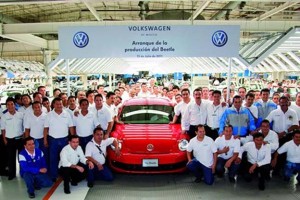
Workers in Puebla gathered to celebrate the launch of production of the latest VW Beetle, one of many new models going South of the Border.
Despite the ongoing recovery of the U.S. market, manufacturers have been extremely reluctant to boost capacity, adding third shifts where absolutely necessary and avoiding, if at all possible, the need to invest in new assembly plants.
It’s an entirely different matter South of the Border. In the months to come, a wide range of automotive manufacturers, including Nissan, Audi and Honda, plan to launch production at all-new plants designed to not only feed rising demand in Mexico itself but which will serve as a major export base for markets around the world.
The boom in Mexican production is meant to take advantage not only of an abundant supply of relatively low cost labor, but also the fact that Mexico has negotiated more free trade agreements than almost any other country in the world.
Earlier this month, Chrysler Group Chairman and CEO Sergio Marchionne traveled to Saltillo, in northern Mexico, where Chrysler is investing $1.249 billion in two new facilities, an investment expected to create more than 1,500 jobs.

Honda CEO Takanobu Ito, (center right) during groundbreaking ceremonies for the maker's soon-to-open plant in Mexico.
Of the total, $1.085 billion was invested in the construction of a new Van Assembly Plant to produce the Ram ProMaster commercial vehicle. The additional $164 million will add a new production line to assemble Tigershark engines at the Saltillo North Engine Plant, Marchionne said.
With the two new plants, Chrysler employment in Saltillo will grow to nearly 6,500 – older Chrysler facilities already employing nearly 5,000 workers there. Both the Ram ProMaster and the Tigershark engine will be exported to different markets, taking advantage of the numerous free trade agreements that Mexico quietly been putting into place with not only its neighbors in the Americas but also with markets in Asia, Europe and Africa.
Located west of Monterey, and barely 300 miles from Texas, the Saltillo facility is close to a network of auto parts plants located along the Mexican side of the U.S. border. But the real growth in the Mexican auto industry is in the center of the country, noted Michael Robinet, a senior analyst with IHS Automotive, where security is better and vehicles can be shipped by sea not only to markets in the U.S. and Canada but also in Latin America, Asia and the Mideast.
Production in mid-Mexico is expected to grow from roughly 2 million units this year to around 3.5 million units by 2020, Robinet said during a recent presentation to the Society of Automotive Analysts. The growth in production in Mexico will rival the surge of new automotive capacity now unfolding in Brazil, Russia and India, three countries in which car sales are expected to grow rapidly over the next decade, Robinet said.
“The surge of new capacity to mid-Mexico is driven by cost, trade access to critical markets, flexibility and final vehicle logistics,” Robinet explained. Also fueling the expansion, he said, is the switch to common global platforms for everything from minicars to full-size vans. That makes it easier for manufacturers to produce a wide range of products at a single plant servicing markets around the world..
Honda, Nissan and Mazda will all open new plants with over the next several months. Audi also is building an assembly line in central Mexico, while sibling Volkswagen continues to expand its complex in the center of the country.
With the rapid growth of production, manufacturers are encouraging major suppliers to open plants there, as well. Several major companies, such as Delphi, Hella and American Axle, already have major operations in Mexico building parts for the local auto industry, as well as foor export.
Robinet added carmakers are also putting transmission and engine plants into Mexico, rather than shipping those key components into the country.
Besides Chrysler’s plans for expanding engine production, Honda has started construction of a new transmission plant in Celaya adjacent to the new automobile plant that will begin mass production early next year of the all-new 2015 Honda Fit, as well as a Fit-based crossover vehicle to follow next autumn.
Rick Schostek, Honda North America senior vice president, said increasing sales of the Fit and the new crossover are a key element in Honda’s plans for increasing sales across North America. The demand for small vehicles will grow and the new operations in Mexico will help Honda reach its sales targets, he said.
With the new 200,000-unit Celaya automobile plant scheduled to begin operation early next year, Honda de Mexico’s annual production capacity will increase to a total of 263,000 units. In 2012, Honda sold 54,000 units in Mexico, up more than 150% from 2011.

Looks like history repeating itself. Companies moving to Mexico just like they didn’t right after NAFTA was passed. Wonder how much each company will have the pay in protection money to the drug lords? Did you know that when a company moves to Mexico that the Mexican government sign a contract with them guaranteeing that the company will never have any labor trouble? In other words, if someone tries to start a union or if some workers start stirring up problems, these people will just disappear. Problem solved. No labor problems.
Suppose to be “ just like they did right after NAFTA was passed.”
built 260K units in Mexico, but only sold 54K there? I thought one of the “benefits” of this whole deal was supposed to be that the Mexican standard of living would rise.
Take away jobs that pay enough to buy the product, then at some point who’s left?
Actually the inflation rate is absurd in mexico and it’s not unusual at all for workers at VW and other auto plants to go out on strike and get a $2/hr. salary increase. Labor is cheap in Mexico but it literally costs VW billions of dollars to educate the workers so they can read, write and be productive.
I’m a firm believer that major automotive vehicles should be produced in the country where they are sold. That would be beneficial to all parties involved from consumer to mfg. Naturally the CEO and stockholders might get a few pennies less on their stock but they could still live quite comfortably with the stock price.